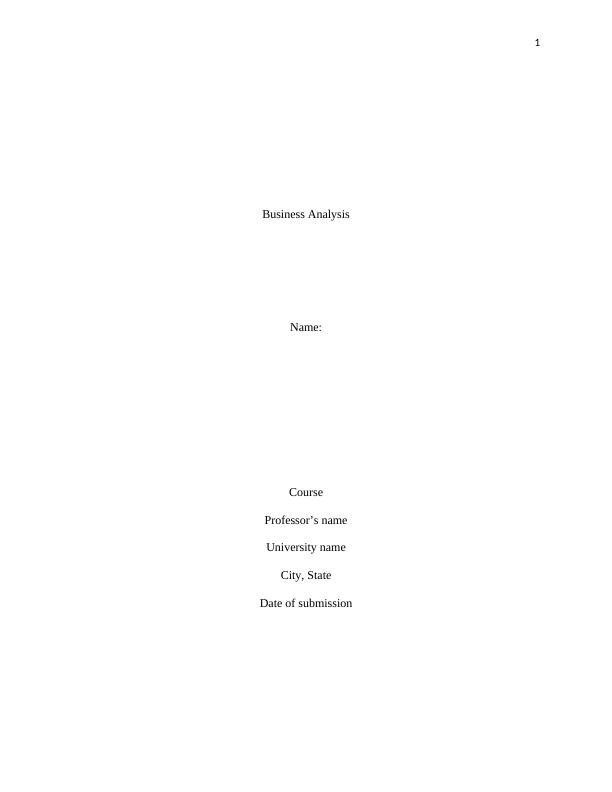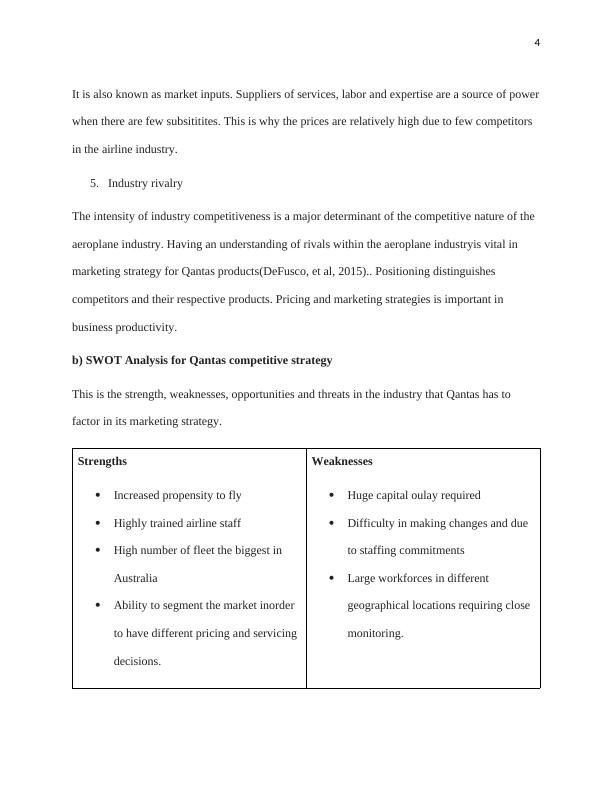Business Analysis of Qantas Airways
Added on 2023-06-07
13 Pages2818 Words89 Views
1
Business Analysis
Name:
Course
Professor’s name
University name
City, State
Date of submission
Business Analysis
Name:
Course
Professor’s name
University name
City, State
Date of submission

2
Introduction
Qantas Airways, is the Australian national flag carrier and the biggest airline in Australia in
terms of fleet size and destinations. It also has the largest international flights and the third oldest
flight in the world after Avianca and KLM. It was founded in 1920 although its passenger flights
for international destinations started later in May 1935 (An, 2014). Its nicknamed the fling
Kangaroo a name coined due to its nationality in Australia. Its main hub is Sydney Airport and
has a majority command in domestic flights at 65%. It carried a total of 14.9% of all the total
passengers flying out of Australia. It has various subsidiaries including Jet connect and Qantas
Link. It is also big in New Zealand and also has a low cost low budget airline by the name Jetstar
airways. Jetstar airlines operated both in domestic and international destinations especially in
New Zealand (Akbar and Stark, 2013).
a) Porters Five forces analysis for Qantas Airline
This is a tool for analyzing competition within the organization. It aims at looking for industry
attractiveness, profitability, competitiveness and general market intensity. The forces include
1. Threat of new entrants
For an aeroplane industry that requires a lot of capital only big organizations can make an entry
in the business. The following factors are inhibitors to market entry, and upon entry makes it
hard for componies to exit.
Government policies
Capital requirements
Absolute cost
Brand equities and economies of scale
Introduction
Qantas Airways, is the Australian national flag carrier and the biggest airline in Australia in
terms of fleet size and destinations. It also has the largest international flights and the third oldest
flight in the world after Avianca and KLM. It was founded in 1920 although its passenger flights
for international destinations started later in May 1935 (An, 2014). Its nicknamed the fling
Kangaroo a name coined due to its nationality in Australia. Its main hub is Sydney Airport and
has a majority command in domestic flights at 65%. It carried a total of 14.9% of all the total
passengers flying out of Australia. It has various subsidiaries including Jet connect and Qantas
Link. It is also big in New Zealand and also has a low cost low budget airline by the name Jetstar
airways. Jetstar airlines operated both in domestic and international destinations especially in
New Zealand (Akbar and Stark, 2013).
a) Porters Five forces analysis for Qantas Airline
This is a tool for analyzing competition within the organization. It aims at looking for industry
attractiveness, profitability, competitiveness and general market intensity. The forces include
1. Threat of new entrants
For an aeroplane industry that requires a lot of capital only big organizations can make an entry
in the business. The following factors are inhibitors to market entry, and upon entry makes it
hard for componies to exit.
Government policies
Capital requirements
Absolute cost
Brand equities and economies of scale

3
Customer loyalty
Industry profitability
With all this factors, it is difficult to make an entry and also to make an exit.
2. Threats to substitute
With differentiated subsitutes, the entry is hard hard. Differentiated subsitutes in airlines industry
ensures that Qantas uses both low cost and high cost products for differentiation. Different
airlines in Australia have different subsitutes for their products. The factors that affect
differentiation include;
Customer propensity to substitute
Costs of switching form one product to another
Availability and ease of substitution
Number of substitute products.
3. Bargaining power of customers
This depends on the market outputs. In airline industry, there is no bargaining power as prices
are set based on profitability, competition, cost and customer demands. The company factors that
affect the bargaining power of customers include; purchasing power of the population of
Australia, Rising prices at traditional resorts, competition from western air carriers and
seasonality of demand(Damodaran, 2016).
.
4. Bargaining power of suppliers
Customer loyalty
Industry profitability
With all this factors, it is difficult to make an entry and also to make an exit.
2. Threats to substitute
With differentiated subsitutes, the entry is hard hard. Differentiated subsitutes in airlines industry
ensures that Qantas uses both low cost and high cost products for differentiation. Different
airlines in Australia have different subsitutes for their products. The factors that affect
differentiation include;
Customer propensity to substitute
Costs of switching form one product to another
Availability and ease of substitution
Number of substitute products.
3. Bargaining power of customers
This depends on the market outputs. In airline industry, there is no bargaining power as prices
are set based on profitability, competition, cost and customer demands. The company factors that
affect the bargaining power of customers include; purchasing power of the population of
Australia, Rising prices at traditional resorts, competition from western air carriers and
seasonality of demand(Damodaran, 2016).
.
4. Bargaining power of suppliers

4
It is also known as market inputs. Suppliers of services, labor and expertise are a source of power
when there are few subsititites. This is why the prices are relatively high due to few competitors
in the airline industry.
5. Industry rivalry
The intensity of industry competitiveness is a major determinant of the competitive nature of the
aeroplane industry. Having an understanding of rivals within the aeroplane industryis vital in
marketing strategy for Qantas products(DeFusco, et al, 2015).. Positioning distinguishes
competitors and their respective products. Pricing and marketing strategies is important in
business productivity.
b) SWOT Analysis for Qantas competitive strategy
This is the strength, weaknesses, opportunities and threats in the industry that Qantas has to
factor in its marketing strategy.
Strengths
Increased propensity to fly
Highly trained airline staff
High number of fleet the biggest in
Australia
Ability to segment the market inorder
to have different pricing and servicing
decisions.
Weaknesses
Huge capital oulay required
Difficulty in making changes and due
to staffing commitments
Large workforces in different
geographical locations requiring close
monitoring.
It is also known as market inputs. Suppliers of services, labor and expertise are a source of power
when there are few subsititites. This is why the prices are relatively high due to few competitors
in the airline industry.
5. Industry rivalry
The intensity of industry competitiveness is a major determinant of the competitive nature of the
aeroplane industry. Having an understanding of rivals within the aeroplane industryis vital in
marketing strategy for Qantas products(DeFusco, et al, 2015).. Positioning distinguishes
competitors and their respective products. Pricing and marketing strategies is important in
business productivity.
b) SWOT Analysis for Qantas competitive strategy
This is the strength, weaknesses, opportunities and threats in the industry that Qantas has to
factor in its marketing strategy.
Strengths
Increased propensity to fly
Highly trained airline staff
High number of fleet the biggest in
Australia
Ability to segment the market inorder
to have different pricing and servicing
decisions.
Weaknesses
Huge capital oulay required
Difficulty in making changes and due
to staffing commitments
Large workforces in different
geographical locations requiring close
monitoring.

End of preview
Want to access all the pages? Upload your documents or become a member.
Related Documents
What is a Business Analysis and What does Business Analyst Dolg...
|17
|1012
|16
Comparison of Services at Jetstar and Qantas Airlineslg...
|9
|2112
|391
Qantas Airways Business Strategy Analysislg...
|15
|4458
|397
Report on Marketing Plan Jetstar Airways Limitedlg...
|10
|2932
|108
Competitive Forces Facing Qantas: Porter's Five Forces Analysislg...
|16
|1566
|439
Business Environment Of Qantas Airways 2023lg...
|7
|1795
|29
